Gomphonema montezumense
-
Category
-
Length Range12.2-19.8 µm
-
Width Range8.9-11.9 µm
-
Striae in 10 µm11.2-14.5
-
ContributorMark Edlund, David R.L. Burge - Dec 2016
-
ReviewerLoren Bahls - Feb 2017
Identification
View image metadata
Type
Description
Valves are rhombic to broadly elliptic, scarcely heteropolar. Ends similar and protracted, rostrate-apiculate. The axial area is narrow and linear. Central area unilateral formed by a 1-4 shortened striae. Opposite the unilateral central area is a long stria that terminates in a single stigmoid positioned near the proximal raphe ends. The raphe is filiform, and slightly arched. The proximal ends are barely expanded, while the terminal ends are indistinct. Striae are widely spaced (more widely spaced in the valve center) and mostly radiate throughout, becoming nearly parallel near at the head and footpoles. Striae are punctate, and the areolae difficult to resolve, 25.0-28.8 in 10 µm. An apical pore field is present, but is indistinct.
Autecology
Gomphoneme montezumense is apparently an endemic, known only from the Montezuma Well National Monument in Arizona. It lives in the epipelon or epilithon. Physical and chemical conditions suggest the well is a stable calcium-bicarbonate thermal spring with an elevated level of sodium chloride. The annual temperature range is 16-26°C. Water quality data are presented by Czarnecki & Blinn (1979): SiO2 = 22 mg/l; Ca = 106 mg/1; Mg = 43 mg/l; Na = 46 mg/l; K = 5.75 mg/l; Cl = 37 mg/l; HCO3 = 680 mg/l; pH = 6.6-6.8.
-
Size Range, µm3
-
Motility
-
Habitat
-
Waterbody
- Learn more about this
Original Description
Valves elliptical to elliptical-lanceolate with irregular margins and protracted rostrate-capitate apices and bases. Axial area narrow, linear; central area small, unilateral, formed by a shortened median stria. The opposite median stria terminates in an isolated punctum. Striae punctate, radiate, 11-14 in 10 µm. Puncta 28 or more in 10 µm. Length 12-23 µm. Width 8-13 µm.
-
AuthorCzarn. and Blinn 1979
-
Length Range12-23 µm
-
Width8-13 µm
-
Striae in 10µm11-14
Citations & Links
Links
-
Index Nominum Algarum
Cite This Page
Edlund, M., Burge, D. (2016). Gomphonema montezumense. In Diatoms of North America. Retrieved January 14, 2025, from https://diatoms.org/species/51950/gomphonema_montezumense
Responses
The 15 response plots show an environmental variable (x axis) against the relative abundance (y axis) of Gomphonema montezumense from all the stream reaches where it was present. Note that the relative abundance scale is the same on each plot. Explanation of each environmental variable and units are as follows:
ELEVATION = stream reach elevation (meters)
STRAHLER = distribution plot of the Strahler Stream Order
SLOPE = stream reach gradient (degrees)
W1_HALL = an index that is a measure of streamside (riparian) human activity that ranges from 0 - 10, with a value of 0 indicating of minimal disturbance to a value of 10 indicating severe disturbance.
PHSTVL = pH measured in a sealed syringe sample (pH units)
log_COND = log concentration of specific conductivity (µS/cm)
log_PTL = log concentration of total phosphorus (µg/L)
log_NO3 = log concentration of nitrate (µeq/L)
log_DOC = log concentration of dissolved organic carbon (mg/L)
log_SIO2 = log concentration of silicon (mg/L)
log_NA = log concentration of sodium (µeq/L)
log_HCO3 = log concentration of the bicarbonate ion (µeq/L)
EMBED = percent of the stream substrate that is embedded by sand and fine sediment
log_TURBIDITY = log of turbidity, a measure of cloudiness of water, in nephelometric turbidity units (NTU).
DISTOT = an index of total human disturbance in the watershed that ranges from 1 - 100, with a value of 0 indicating of minimal disturbance to a value of 100 indicating severe disturbance.

Gomphonema montezumense
- Valves rhombic to broadly elliptical
- Valves scarcely heteropolar
- Striae widely spaced
- Striae radiate
- Apical pore field indistinct
Valves are rhombic to broadly elliptic, and scarcely heteropolar. Striae are widely spaced and radiate throughout. An apical pore field is present, but is difficult to distinguish.
 Diatoms of North America
Diatoms of North America








